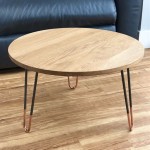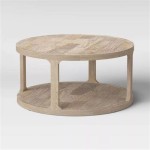```html
How To Restore A Coffee Table
A coffee table often serves as a focal point in a living room, bearing the brunt of daily life. Scratches, water rings, and general wear and tear can diminish its appearance over time. Restoring a coffee table is a worthwhile endeavor that can breathe new life into the piece, revitalizing a room's aesthetic and preserving a valued item. This process, while rewarding, requires patience, attention to detail, and the appropriate tools and materials. The complexity of the restoration depends largely on the extent of the damage and the desired outcome.
Before starting the restoration process, careful assessment is crucial. Evaluating the condition of the coffee table allows for a clear understanding of the required steps. Determine the type of finish currently on the table – is it varnish, lacquer, shellac, or something else? This identification influences the choice of appropriate stripping and refinishing products. Note the severity of any scratches, dents, or stains. Deep damage may necessitate more extensive repairs, such as wood filling or even veneer replacement. Documenting the existing condition with photographs can also be helpful as a reference point throughout the restoration.
Gathering the necessary tools and materials is essential for a smooth and efficient restoration. This includes items such as: chemical stripper (if removing the existing finish), safety goggles, chemical-resistant gloves, drop cloths, a scraper, sanding blocks or an orbital sander, various grits of sandpaper (ranging from coarse to fine), wood filler (if needed), wood stain (optional, if changing the color), a topcoat finish (varnish, polyurethane, lacquer, etc.), application brushes or spray equipment, tack cloth, and mineral spirits or denatured alcohol for cleaning.
Stripping the Old Finish
Removing the existing finish is often the first step in restoring a coffee table, particularly if the finish is damaged or peeling. This process prepares the surface for subsequent sanding and refinishing. Begin by protecting the work area with drop cloths to prevent damage from the stripping agent. Put on safety goggles and chemical-resistant gloves to protect skin and eyes from irritation.
Apply the chemical stripper generously and evenly to the entire surface of the coffee table, following the manufacturer's instructions. Allow the stripper to dwell for the recommended time, which typically ranges from 15 to 30 minutes, depending on the stripper's formulation and the thickness of the finish. The old finish should begin to bubble or soften.
Once the finish has softened, use a scraper to carefully remove the loosened material. Work with the grain of the wood to avoid gouging or scratching the surface. For intricate areas or carvings, use a detail scraper or a stiff brush to remove the finish. Dispose of the stripped finish according to local regulations.
After scraping, clean the surface thoroughly with mineral spirits or denatured alcohol to remove any remaining stripper residue. This is a critical step, as any remaining stripper can interfere with the adhesion of the new finish. Allow the surface to dry completely before proceeding to the next step.
Sanding and Repairing Imperfections
Sanding is a crucial step in preparing the surface for a new finish. It removes any remaining traces of the old finish, smooths the surface, and provides a "key" for the new finish to adhere to. Begin with a coarser grit sandpaper (e.g., 80-grit or 100-grit) to remove any imperfections and smooth out the surface. Work with the grain of the wood to avoid creating scratches.
Progressively move to finer grits of sandpaper (e.g., 120-grit, 180-grit, and finally 220-grit) to refine the surface and create a smooth, even texture. Sanding with progressively finer grits ensures that any scratches left by the coarser grits are removed. An orbital sander can be used for larger, flat surfaces, while sanding blocks are better suited for edges and intricate areas.
Inspect the surface carefully for any dents, gouges, or imperfections. If such imperfections exist, use wood filler to fill them. Apply the wood filler according to the manufacturer's instructions, ensuring that it fills the entire void and is slightly proud of the surrounding surface. Allow the wood filler to dry completely.
Once the wood filler is dry, sand it flush with the surrounding surface using fine-grit sandpaper (e.g., 220-grit or 320-grit). Blend the edges of the filled area seamlessly with the surrounding wood. Remove all sanding dust with a tack cloth before proceeding to the next step.
Staining and Applying the Topcoat
Staining is an optional step, depending on whether the desired outcome is to maintain the natural wood color or to change it. If staining, choose a stain that complements the wood type and the overall aesthetic of the room. Apply the stain evenly to the surface using a brush, cloth, or sponge, following the manufacturer's instructions. Allow the stain to dwell for the recommended time, and then wipe off any excess stain with a clean cloth.
The application of the topcoat is the final step in protecting the restored coffee table and providing a durable, attractive finish. Choose a topcoat that is appropriate for the table's intended use and the desired level of sheen (e.g., matte, satin, semi-gloss, or gloss). Common topcoat options include varnish, polyurethane, and lacquer. Polyurethane is often preferred for its durability and water resistance.
Apply the topcoat in thin, even coats, following the manufacturer's instructions. Use a high-quality brush or spray equipment to ensure a smooth, even application. Allow each coat to dry completely before applying the next coat. Lightly sand between coats with very fine-grit sandpaper (e.g., 320-grit or 400-grit) to remove any imperfections and create a smooth surface for the next coat. Apply at least two to three coats of topcoat for optimal protection and durability.
After the final coat of topcoat has dried completely, allow the finish to cure for the recommended time, which can range from several days to a week, depending on the type of finish. Avoid placing items on the coffee table during the curing process to prevent damage to the finish. Once the finish has fully cured, the restored coffee table is ready to be enjoyed.
Throughout the entire process, maintaining a clean workspace is crucial. Dust and debris can easily contaminate the finish, leading to imperfections. Regularly vacuum or sweep the work area and use a tack cloth to remove any dust from the coffee table before applying each coat of finish. Proper ventilation is also important, especially when working with chemical strippers and finishes. Wear a respirator mask to protect against harmful fumes.
```
More Like Home Round Coffee Tables 4 Easy To Build Styles Day 10

Coffee Tables Everything You Need To Know Styling Tips

Coffee Table Styling Loepsie

How We Built A Modern Farmhouse Coffee Table Diy Beautify Creating Beauty At Home

Round Coffee Table Decor West Elm Designer Tips Tricks

Easy Coffee Table Styling Like A Designer Joyful Derivatives

How To Re Invent Your Old Coffee Table With Paint The Boondocks Blog

How To Style A Coffee Table Temple Webster

How To Re Invent Your Old Coffee Table With Paint The Boondocks Blog

Coffee Table Books And How To Style Them Fab Home Blog







